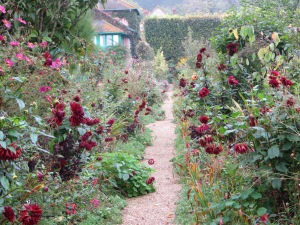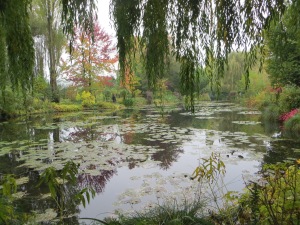At the Musée de l’Orangerie, Monet’s water lilies hang in a 360 degree panoramic display. The panels are placed in a gentle curve, side by side, so when you walk along the walls or spin around in circles, the brushstrokes congeal into flowers and pond water. You’re in the middle of it all. You can pretend that you are walking on water.
Alternatively, if your imagination can only take you so far into Monet’s world, hop on a SNCF train and in a half hour, it’ll drop you off at Vernon, where you take a quick bus ride to Giverny, Monet’s home and the setting of many of his famous works. Giverny is a village. We walked down one main row that featured Monet’s preserved house, a small museum of Impressionist paintings and sketches, a hotel, some shops, an art gallery, a couple of homes, and a goat. You could mistake it for the middle of nowhere, if you’re not careful.
Monet’s house was a cozy, two-story building with kelly green shutters. Inside, copper pots hung inside a tiled kitchen. The bedroom windows opened onto a view of the landscaped rows of flowers below. Many of his works hung on the walls of the library, but the museum guard told us they were all reproductions. “The Monet Foundation does not have that kind of money.” Alas, such is life.
The house was everything you would expect for a comfortable, country home. It was large, spacious, and bright, probably the size of a suburban McMansion with none of the pretension and gaudiness. However, as lovely as the house was, the gardens were dazzling. We had postponed the trip several times because the forecast predicted rain, but the gardens close in November, so we finally went, two weekends before the 31st despite what the meteorologists said. Luckily, the clouds eventually faded into sunshine. Even more fortunate, flowers were spilling all over the walkways with no regard for the chilly fall weather. Wild, hardy-looking roses climbed trellises while color-coordinated rows of mums, daises, foxglove swung idly as visitors passed by.
We walked along a small brook where a dense forest of bamboo had colonized a small island. But the pièce de résistance was the pond. The water was reflective, smooth, and yes, still covered by a thin layer of water lilies. Willow trees dangled their branches over a Japanese bridge.
If walking around the Musée de l’Orangerie was a little vertigo inducing, this was like being catapulted into another realm. It was sweeping, vibrant, and green. Even though Monet’s water lily paintings can sometimes veer into the abstract, he captured it all – the all-over light, the way the willow branches just barely touch the water, how dense the water seems to be when you’re looking right above it, the floating water lilies that look like stickers that you can peel off and stick to a windowpane. To have all this, right in your backyard.
(By the way, the French word for water lilies is les nymphées. Not knowing that it was a false cognate, I spent many a moment expecting to see a Monet painting depicting mythical water spirits.)

